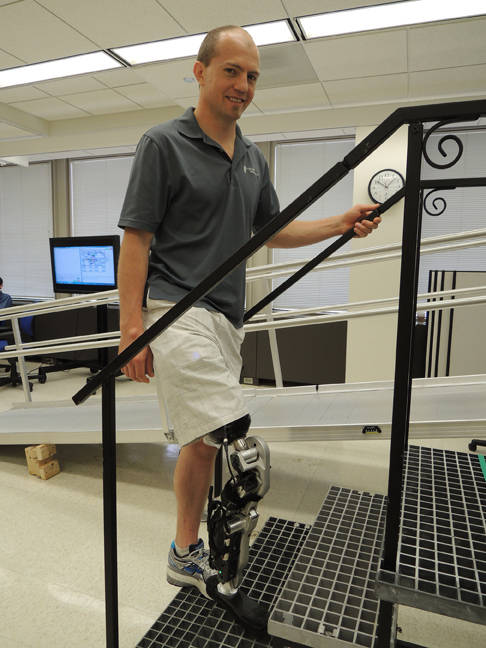First 'Thought-Controlled' Bionic Leg Funded Through Army Medicine Research

Researchers unveiled the world's first thought-controlled bionic leg Sept. 25, funded through the US Army Medical Research and Materiel Command's (USAMRMC) Telemedicine and Advanced Technology Research Center (TATRC) and developed by researchers at the Rehabilitation Institute of Chicago (RIC) Center for Bionic Medicine.
The New England Journal of Medicine highlighted the project that marked a milestone for prosthetics. Until now, this type of technology was only available for arms. While the bionic legs aren't for sale yet, researchers are hoping they may be available commercially in as little as five years.
"More than1,600 service members returning from Iraq and Afghanistan have sustained amputations," said Col. John Scherer, director of USAMRMC's Clinical and Rehabilitative Medicine Program. "Our goal is to help these men and women participate fully in life."
Scherer added that may mean returning to active-duty or gainful employment in the civilian sector.
"This research is an important step to make the choice theirs, rather than the injury being a deciding factor," said Scherer. "While we want to keep as many of these individuals on active duty as possible, we recognize that some of them must move on to civilian lives due to the severity of their injuries."
In fact, this technology can apply to civilian leg amputees as well. According to the National Limb Loss Information Center, there may be more than 1 million amputees in the U.S.
One such civilian amputee is 32-year-old Zac Vawter, who served as RIC's "test pilot" for the project's first bionic leg. Vawter is a software engineer who lives in Seattle with his wife and two children. In 2009 he lost his leg in a motorcycle accident.
Vawter firist underwent a cutting-edge procedure called "Targeted Muscle Reinnervation" developed by RIC and Northwestern University. Surgeons redirected nerves from Vawter's damaged muscle in his amputated limb to healthy muscle above his knee.
Then Vawter started learning how to use the thought-controlled bionic leg. The leg is controlled using a computer chip that is similar to those in modern smartphones. As muscles contract, they generate signals that are detected by sensors and analyzed by the computer chip. A specially-designed computer program analyzes these signals and data from sensors in the leg. It instantaneously decodes the type of movement Vawter is trying to perform and then sends those commands to the leg. Using muscle signals in addition to robotic sensors makes the system safer and more intuitive, according to researchers.
Using the bionic leg, Vawter can walk up ramps and stairs, and transition between these activities without stopping. He was also able to use his thoughts to change the position of his lower leg while sitting down, something that cannot be done with current motorized leg prosthetics.
"This new bionic leg features incredibly intelligent engineering," said Levi Hargrove, PhD, the lead scientist of this research at RIC's Center for Bionic Medicine. "It learns and performs activities unprecedented for any leg amputee, including seamless transitions between sitting, walking, ascending and descending stairs and ramps and repositioning the leg while seated."
Vawter's bionic leg is a prototype. When he is not working with the research team, Vawter uses a regular prosthetic.
"The bionic leg is a big improvement compared to my regular prosthetic leg," said Vawter, in a statement. "The bionic leg responds quickly and more appropriately, allowing me to interact with my environment in a way that is similar to how I moved before my amputation."
The bionic leg may also help prevent falls. Vawter's robotic leg had an error rate of about 12 percent. This was reduced to less than 2 percent with the bionic leg, according to researchers.
Vawter added, "This is a huge milestone for me and for all leg amputees."














